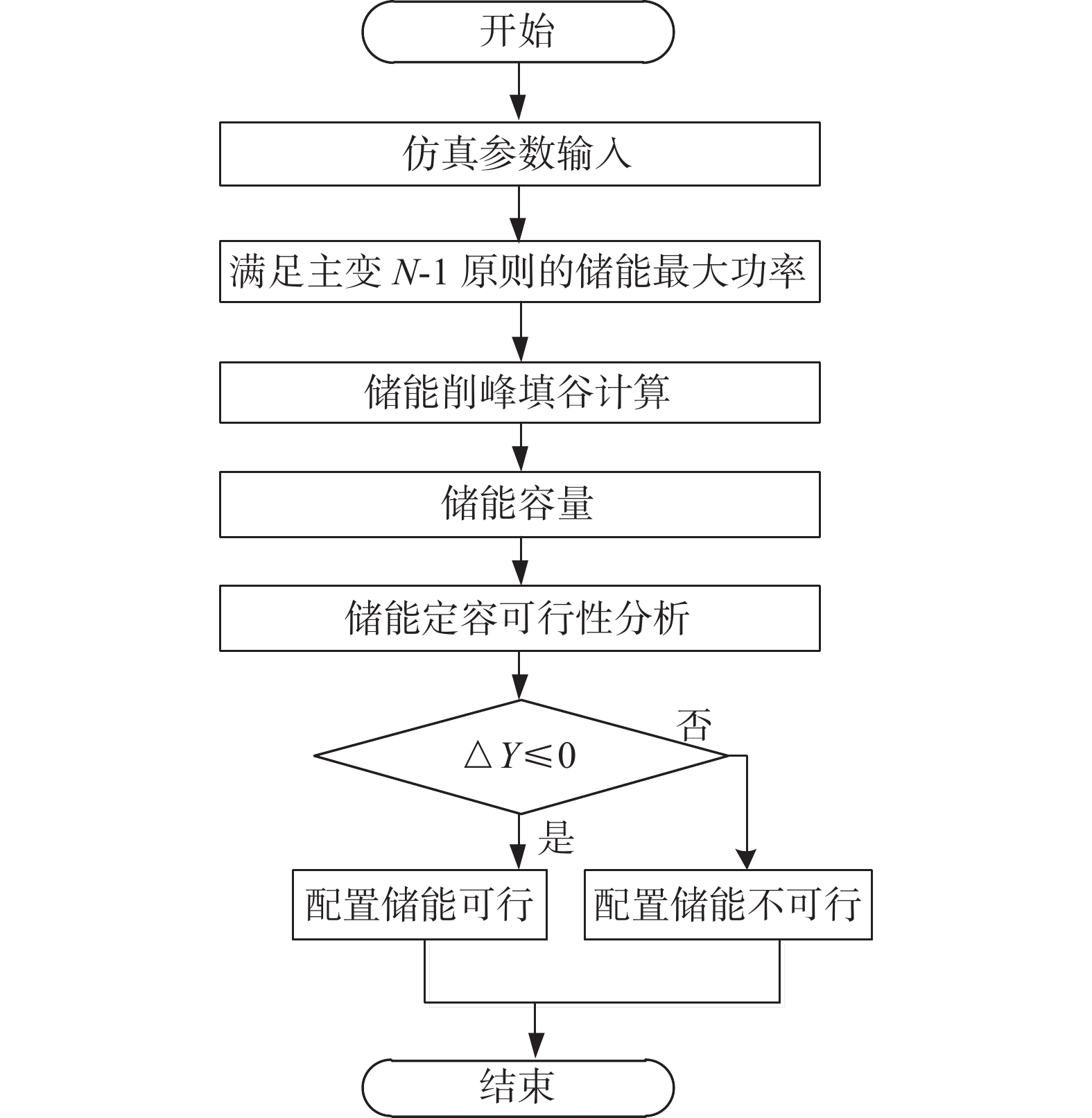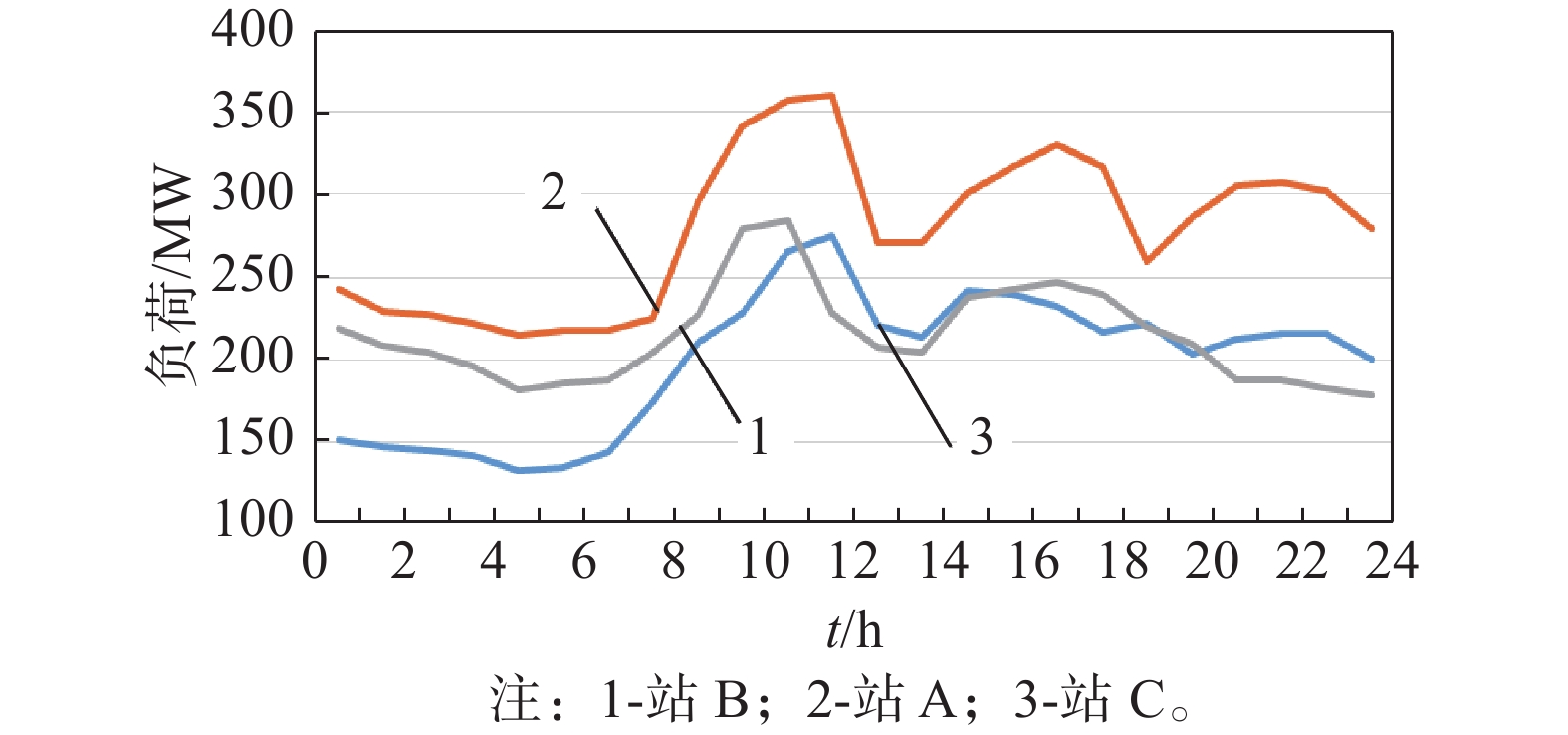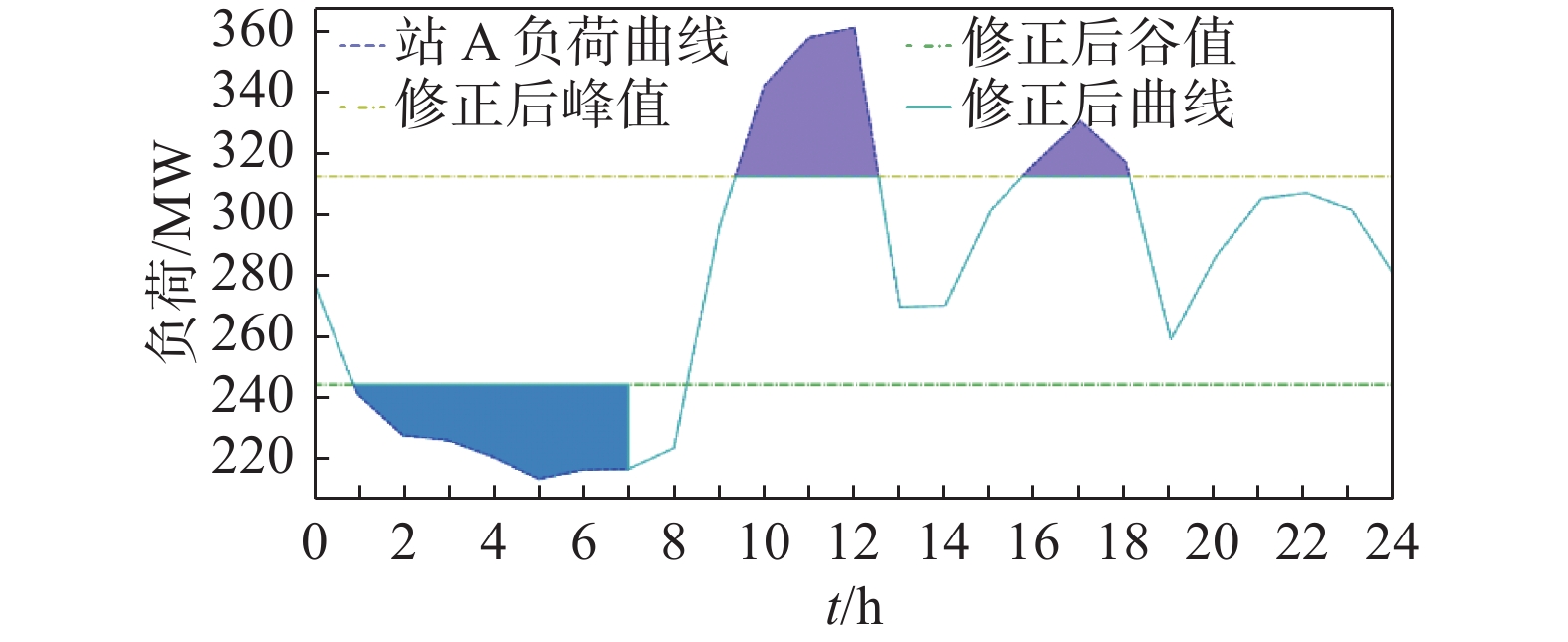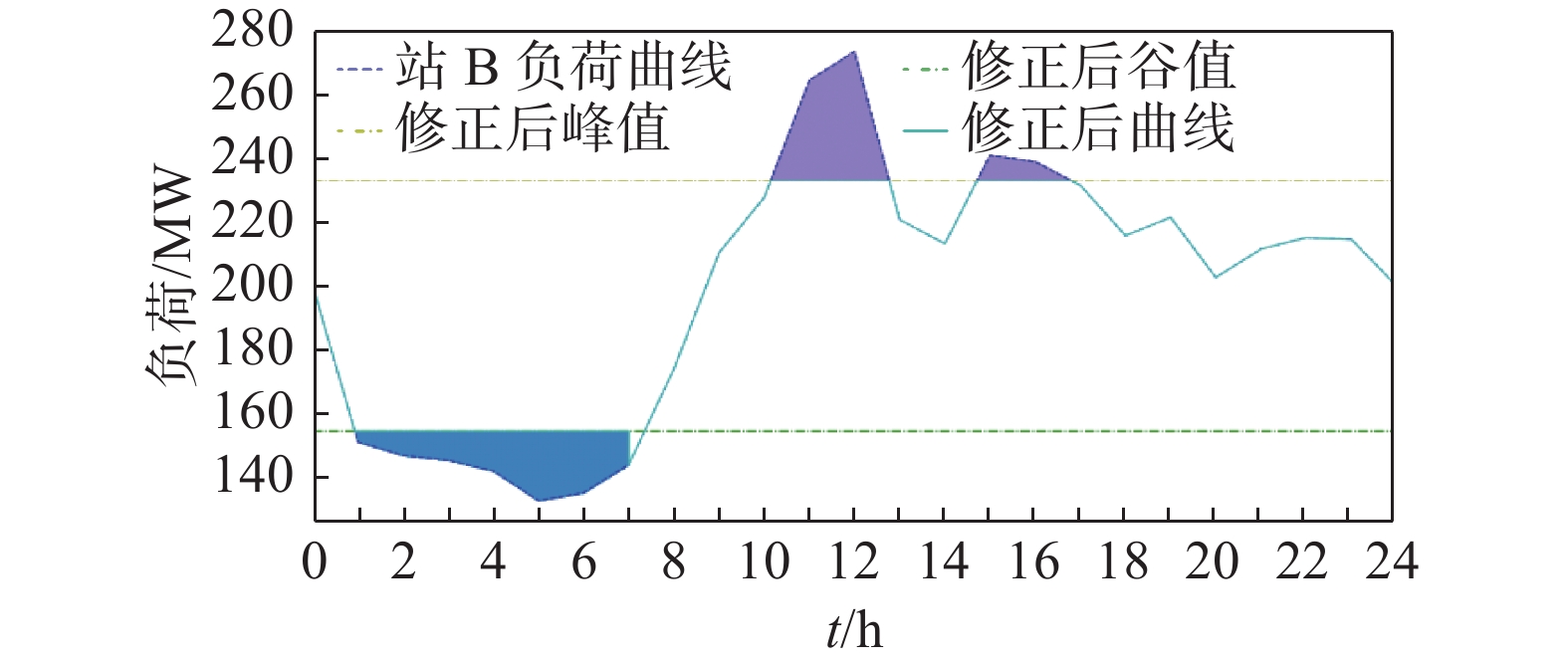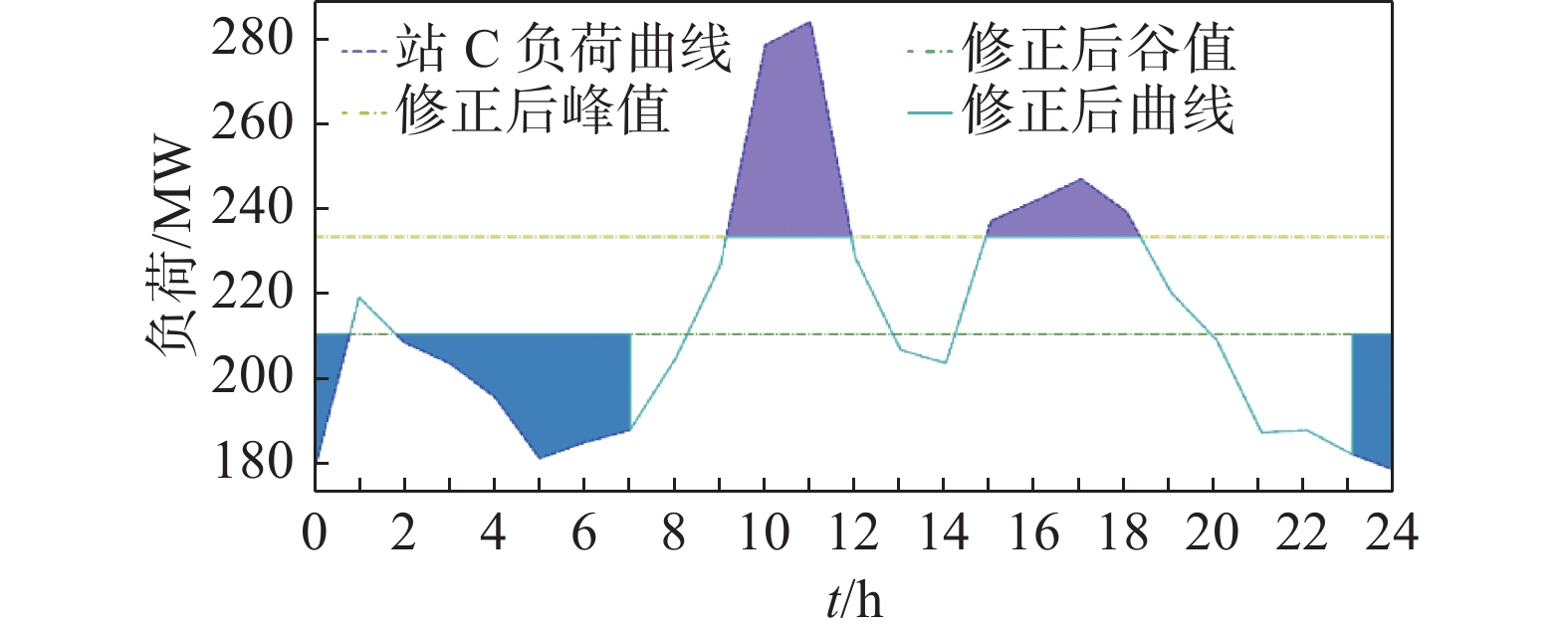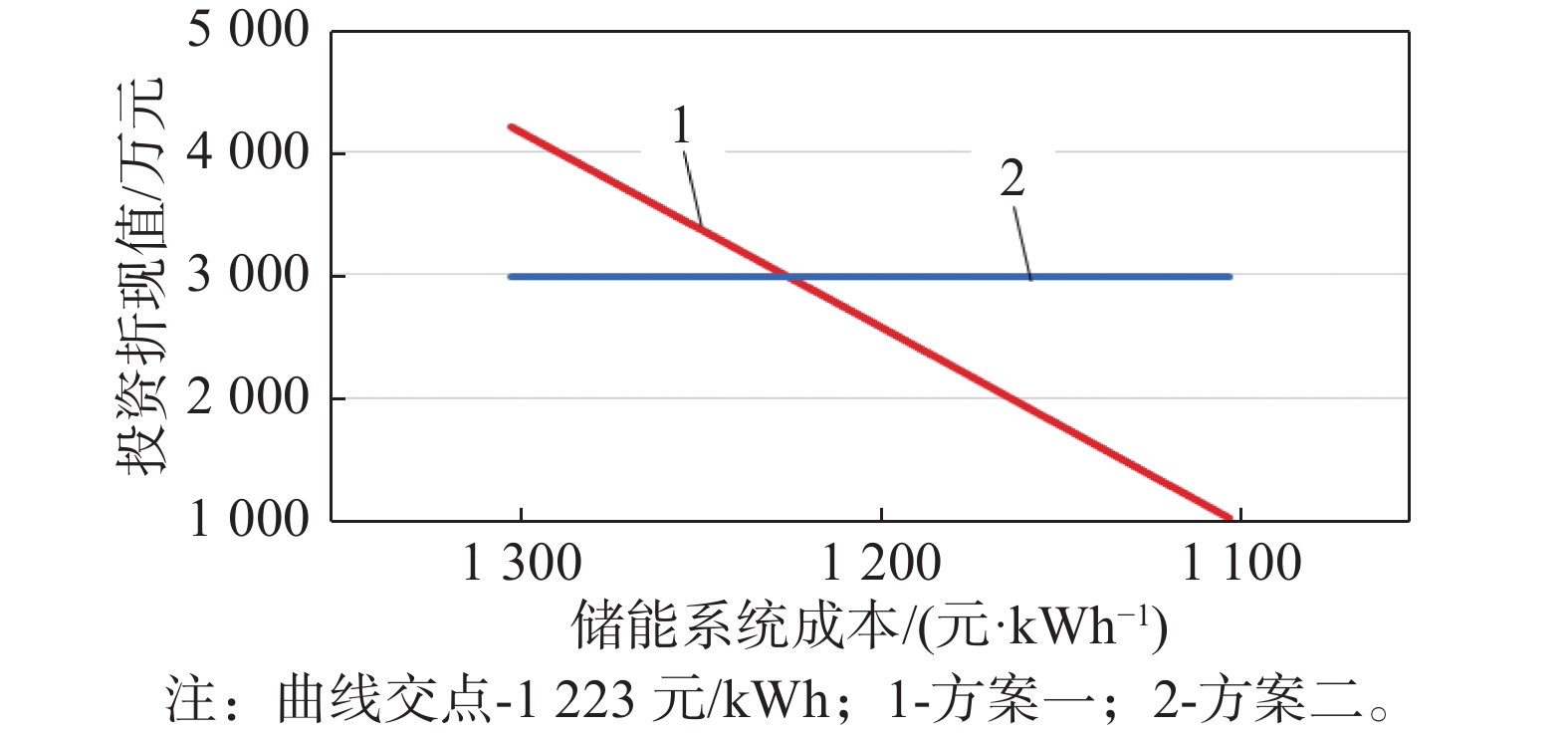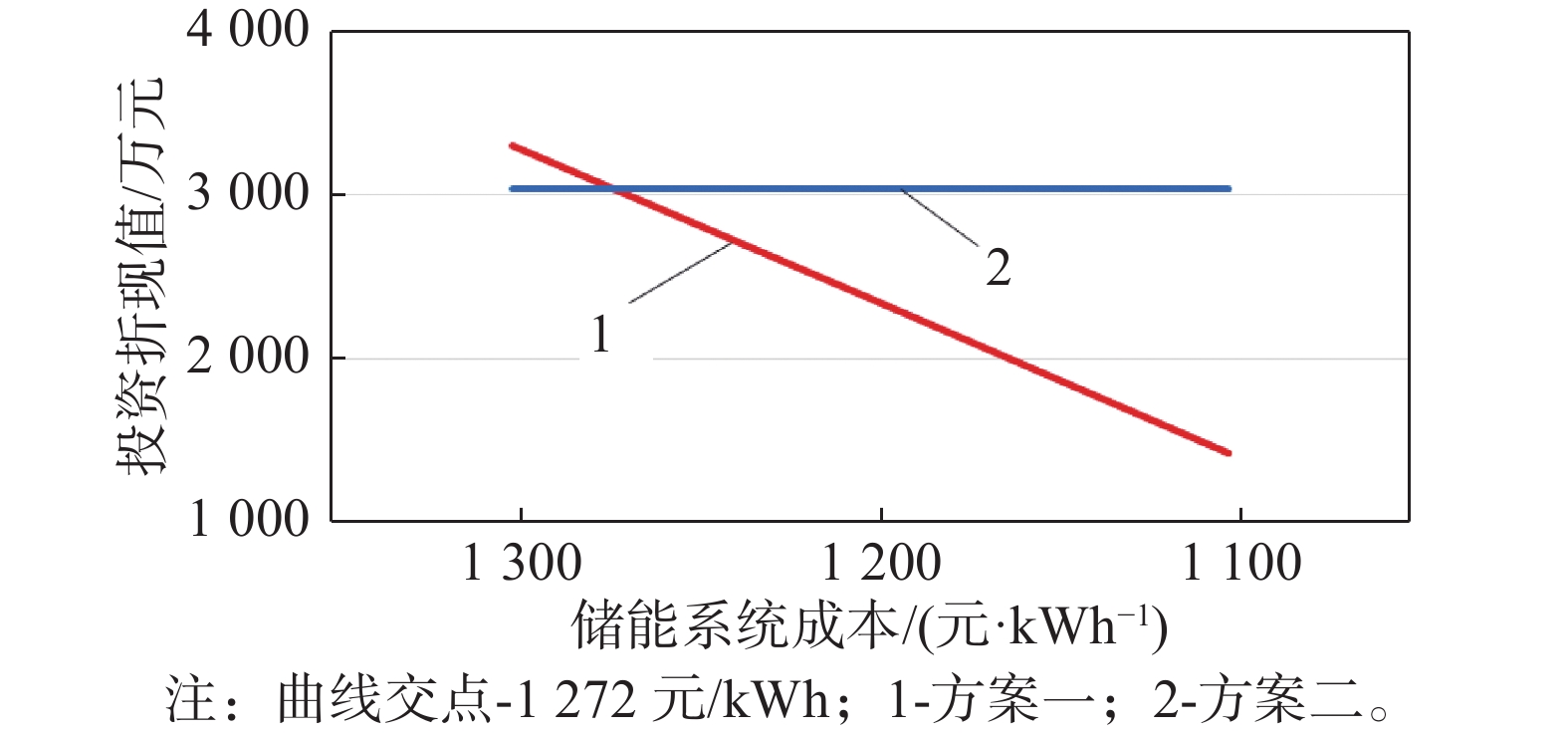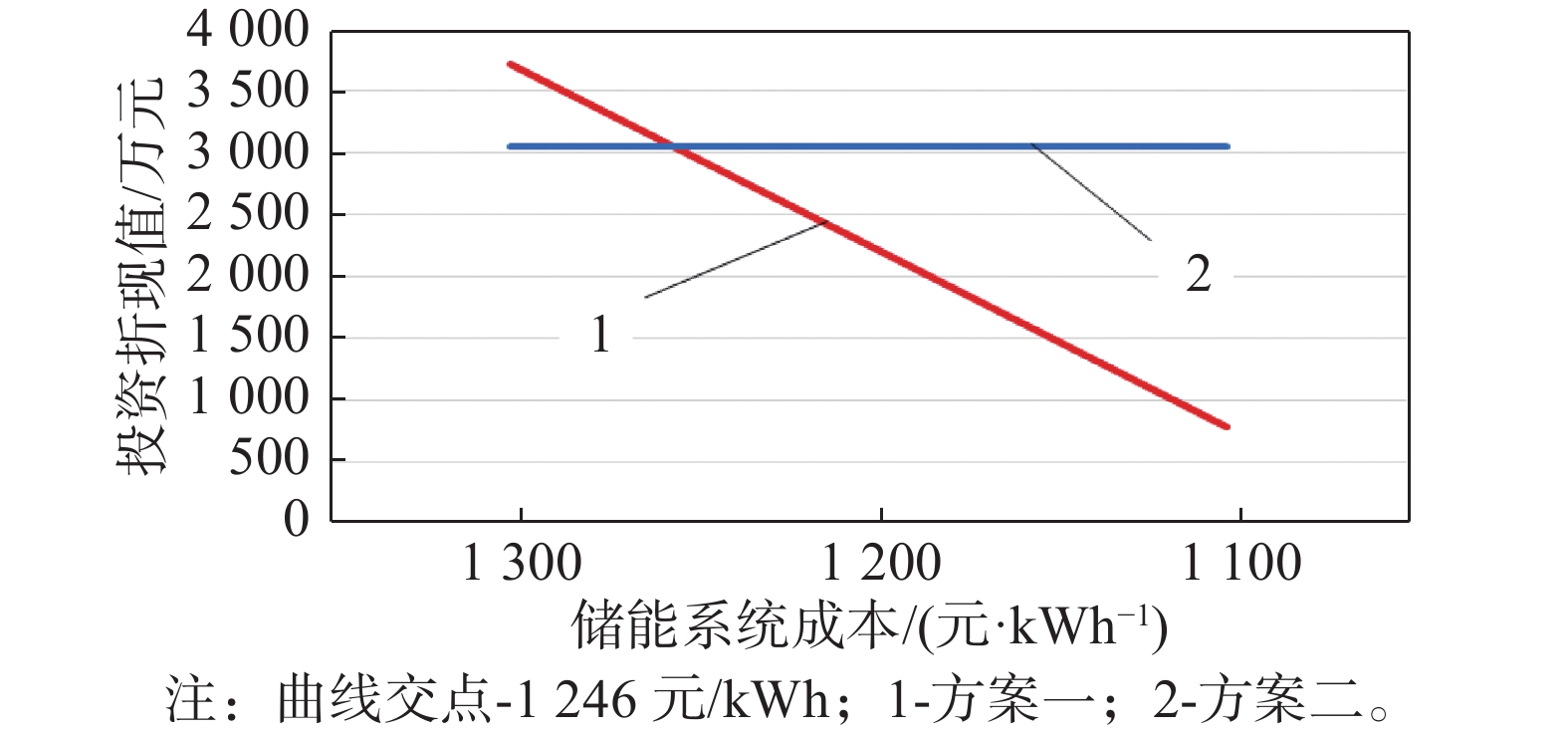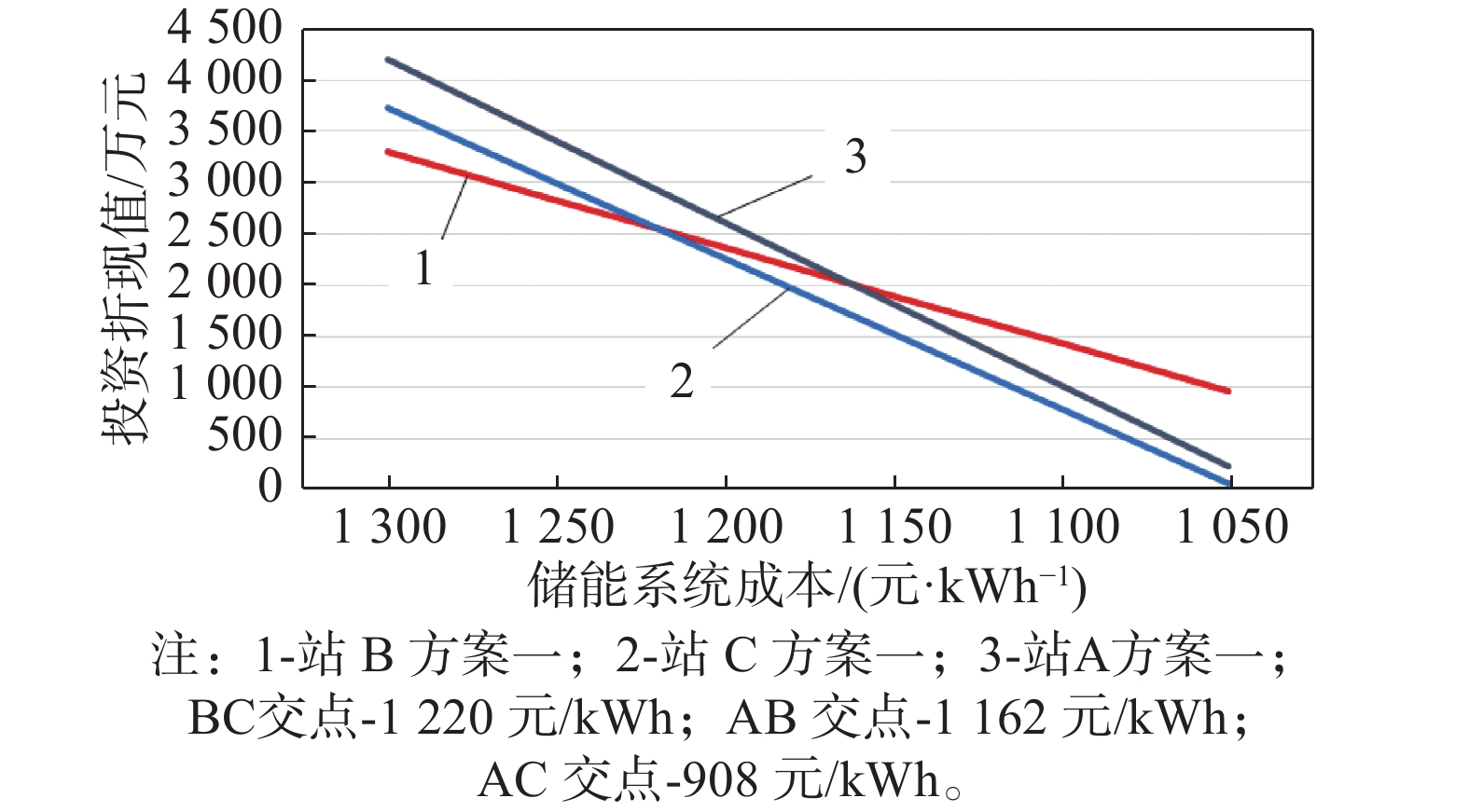-
随着经济社会的不断发展,负荷日益增加,系统调峰负担逐渐增大[1-2]。储能装置具备削峰填谷[3-5]、改善电力系统电能质量[6-8]、推迟输变电网投资建设[9-10]、延缓发电装机配置[11]的特点,可以提升变电站供电能力[12]、满足安全运行要求[13-15],为今后储能在电网中的规模化应用提供参考。因此,开展电网侧储能定容分析是必要的。
目前,储能在电网侧配置已见较多研究。向育鹏[16]基于差分进化和预测-校正内点法的混合算法求解以配电网储能系统全寿命周期净收益为目标的最佳配置;吴小刚[17]从负荷波动、节点电压波动等方面建立储能多目标定容优化模型,应用改进多目标粒子群算法求解;尤毅[18]以改善电压质量、提供馈线主动调节以及提高削峰填谷等能力,建立储能多目标定容模型,并应用改进PSO算法求解等。
以上文献多以经济性或技术性单方面开展分析,未综合技术经济性进行定容。为综合多方因素,安东[19]以投资经济性以及配电网运行的电压质量和功率稳定性为目标,设计改进的多目标蜉蝣算法进行选址定容;陆立民[20]综合负荷波动和系统成本采用改进多目标粒子群算法进行储能优化配置等。
以上储能定容研究主要是以系统电压波动、电压质量等作为优化目标,研究配电网络储能选址及最优容量配置,经济性分析主要涉及储能系统成本等,未考虑实际电网运行如主变负载率、变电容量等相关参数及延缓输变电网投资带来的经济效益,缺乏实用性。且以上研究未针对现有电网变电站短时重载问题提出配置电网侧储能解决方案。
本文首先根据储能参与削峰填谷机理,建立储能定容数学模型,计算特定运行负荷曲线下,满足设定目标的储能规模;然后,根据储能投资收益组成构建锂离子电化学储能定容经济目标函数;最后,结合待选变电站,分析本文所提方法在不同场景的储能配置,并结合传统输变电工程建设投资开展经济性分析,提出建议的变电站配建储能容量和经济可行的储能建设成本。经计算,本文提出储能定容方法可以有效解决主变短时重载问题,且随着储能技术发展,待电化学储能系统建设成本降低后,该配置方案将具备较传统输变电工程更优的经济效益。
-
储能定容的主要参数为储能的额定功率和额定容量。
1) 储能额定功率
为满足变电站主变N-1要求,变电站正常运行时,最高负载率应低于设定值;且为实现变电站经济运行,变压器峰谷差率也应低于设定值。
因此,储能参与削峰填谷,储能额定功率配置应满足给定峰谷差率下,削峰、填谷所需的最大功率。
$$ P_{{\rm{CN}}}={{\rm{max}}} \left\{\left[P(t)-P_{{\rm{xf}}.{\rm{max}} }\right],\left[P_{\rm{tg.min}}-P(t)\right]\right\} $$ (1) 式中:
PCN ——储能额定功率(MW);
P(t) ——典型日负荷曲线函数;
Pxf.max ——削峰后峰值(MW);
Ptg.min ——填谷后谷值(MW)。
2) 储能额定容量
储能参与削峰填谷,储能额定容量配置应不少于削峰所需电量,且削峰电量等于填谷电量。
$$ Q_{{\rm{xf}}}=\displaystyle \sum\limits \left(\int_{t_{{\rm{fs}}}}^{t_{{\rm{fe}}}}\left[P(t)-P_{{\rm{xf}}.{\rm{max}}}\right] {\rm{d}}t\right) $$ (2) $$ Q_{{\rm{tg}}}=\displaystyle \sum\limits\left(\int_{t_{{\rm{gs}}}}^{t_{{\rm{ge}}}}\left[P_{{\rm{tg}}.{\rm{min}}}-P(t)\right] {\rm{d}}t\right) $$ (3) $$ \eta_{{\rm{CN}}} Q_{{\rm{CN}}}=Q_{{\rm{xf}}}=Q_{{\rm{tg}}} $$ (4) $$ P(t)-P_{{\rm{xf}}.{\rm{max}} }>0 $$ (5) $$ P_{{\rm{tg}}.{\rm{min}}}-P(t)>0 $$ (6) 式中:
QCN ——储能额定容量(MWh);
Qxf ——削峰电量(MWh);
Qtg ——填谷电量(MWh);
tfs ——储能削峰开始时刻(h);
tfe ——储能削峰结束时刻(h);
tgs ——储能填谷开始时刻(h);
tge ——储能填谷结束时刻(h);
ηCN ——储能充放电系数。
储能参与削峰填谷工作位置示意图如图1所示。
-
储能建设降低变压器高峰负载率,提高变压器降压利用小时数,可延迟变压器主变扩建或增容时序,从而获取建设投资的时间效益。
在满足负荷运行可靠性原则下,对比如下方案:
方案一:变电站本期配置储能,3~5 a后扩建一台主变;
方案二:变电站本期扩建一台主变,3~5 a后进行主变增容。
其中,为保证各方案供电能力一致,方案二3~5 a后增加的主变容量供电能力等同于方案一配置储能。
上述方案投资涉及储能成本、主变扩建成本、储能维护费用、主变维护费用以及储能峰谷差效益。各项投资具体说明如下:
1)方案一总投资
$$ {Y}_{1}={C}_{11}+{C}_{12}+{C}_{13}+{C}_{14}-V $$ (7) (1)储能成本C11
$$ {C}_{\text{11}}={C}_{{\rm{E}}}\cdot E\cdot{10}^{-1} $$ (8) 式中:
E ——储能额定容量(MWh);
CE ——电池储能系统单位容量成本(元/kWh)。
(2)主变扩建成本C12
$$ {C}_{12}={C}_{{\rm{ZB}}}\cdot\dfrac{1}{{\left(1+i\right)}^{{n}_{1}}} $$ (9) 式中:
CZB ——扩建主变的投资(元/kWh);
i ——贴现系数;
n1 ——延缓主变扩建的年数(a)。
(3)储能维护费用C13
$$ C_{13}=\eta_{\rm{E}} \cdot C_{\rm{E}} \cdot E \cdot \frac{(1+i)^n-1}{i \cdot(1+i)^n} $$ (10) 式中:
n ——储能寿命(a);
ηE ——储能维护系数。
(4)扩建主变的维护费用C14
$$ C_{14}=\eta_{{\rm{ZB}}} \cdot C_{{\rm{ZB}}} \cdot \frac{(1+i)^{n-n_1}-1}{i \cdot(1+i)^{n-n_1}} $$ (11) 式中:
ηZB——主变维护系数。
(5)储能峰谷差收益V
$$ V=C_{\rm{V}} \cdot E \cdot \displaystyle \sum\nolimits_{n=1}^{15}\left(\dfrac{1-k}{I+i}\right)^n $$ (12) 式中:
CV——储能每年单位峰谷差收益(元/kWh)。
2)方案二总投资
$$ Y_2=C_{21}+C_{22}+C_{23}+C_{24}-V $$ (13) (1)主变容量增加等同于方案一储能功率供电能力的成本C21
$$ C_{21}=\left(\frac{P_{{\rm{CN}}}}{S_{{\rm{ZB}}}} \cdot C_{{\rm{ZB}}}\right) \cdot \dfrac{1}{(1+i)^{n_1}} $$ (14) 式中:
PCN ——储能额定功率(MW);
SZB ——主变扩建容量(MVA)。
(2)主变扩建成本C22
$$ C_{22}=C_{{\rm{ZB}}} $$ (15) (3)主变容量增加的维护费用C23
$$ C_{23}=\eta_{\rm{E}} \cdot C_{21} \cdot \frac{(1+i)^{n-{n_1}}-1}{i \cdot(1+i)^{n-{n_1}} } $$ (16) (4)扩建主变的维护费用C24
$$ C_{24}=\eta_{{\rm{ZB}}} \cdot C_{22} \cdot \dfrac{(1+i)^n-1}{i \cdot(1+i)^n} $$ (17) 3)目标函数
本文依据储能建设成本与推迟主变扩建投资两者之间找到平衡,构建储能定容经济目标函数:
$$ \Delta Y=Y_1-Y_2 \leqslant 0 $$ (18) 式中:
ΔY=0为变电站配置储能最低应满足的经济条件;若ΔY<0,则说明该站本期配置储能比扩建主变具有更优的经济性。
易知,在其余系数不变时,储能建设投资与储能系统单位容量成本呈线性关系。目前储能系统成本较高(2 000元/kWh),但随着未来储能技术的提升,储能单位造价也将持续降低。因此,下文基于上述趋势进行储能定容经济可行性分析。
-
变电站储能定容方法总体流程详如图2所示,主要步骤如下:
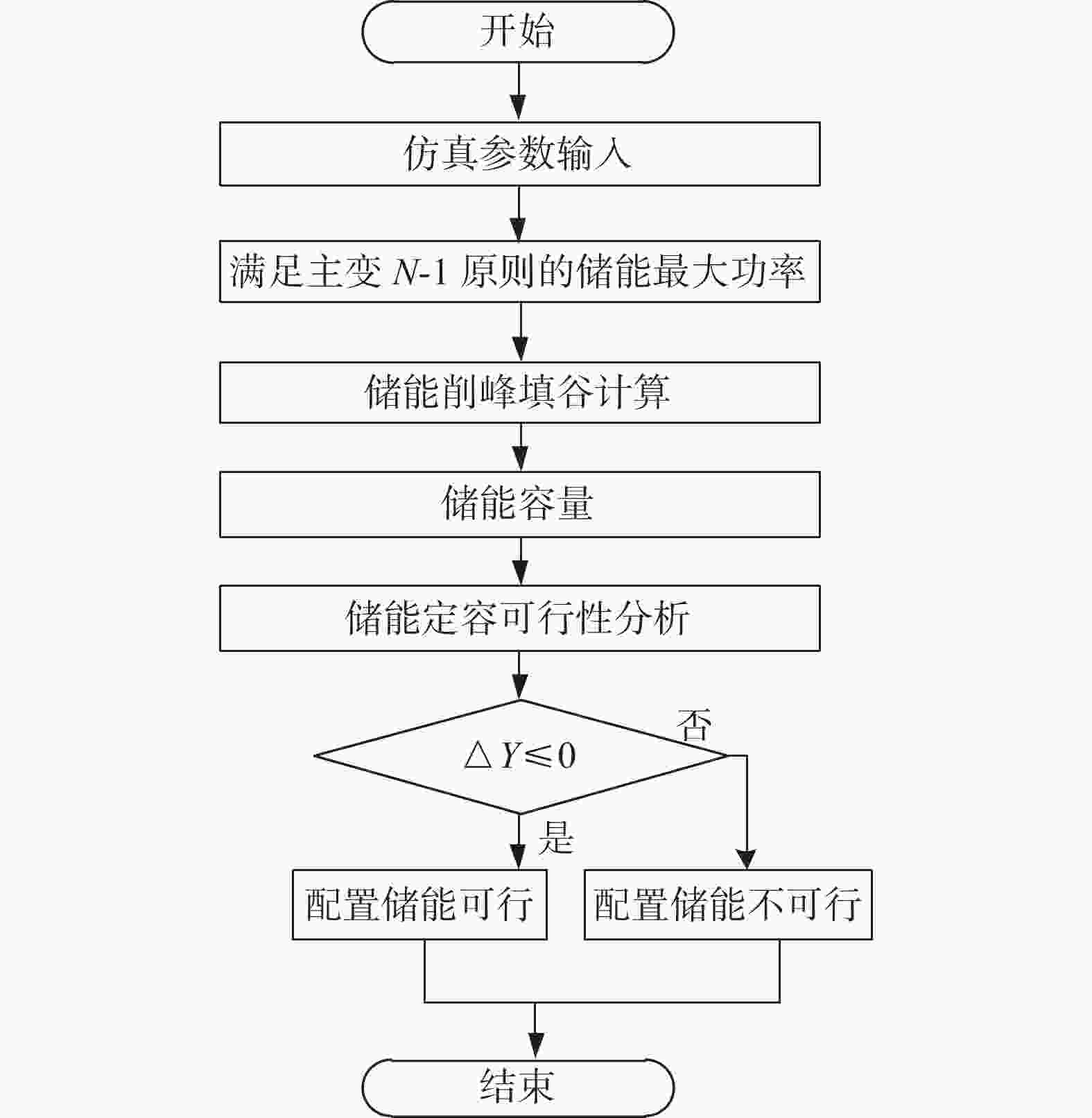
Figure 2. Process chart of capacity sizing method of energy storage in substations meeting N-1 criterion of main transformers
1)根据变电站容量以及变电站年均负荷增长率,以满足主变N-1为原则,确定储能额定功率PCN,使主变扩建推迟3~5 a。具体为:设变电站3~5 a后预测最高负荷为Pmax,满足主变N-1原则的变电站最高负荷限值为Plimit(Plimit小于变电站主变N-1后剩余主变容量1.3倍),令Pxf.max=Plimit,则PCN由式(19)决定:
$$ {P}_{{\rm{CN}}}={P}_{{\rm{max}}}-{P}_{{\rm{limit}}} $$ (19) 2)结合变电站典型负荷曲线及储能额定功率,利用式(2)、式(4)、式(5)计算储能将变电站最高负荷削峰至给定值时所需削峰容量Qxf,确定储能额定容量QCN。
3)根据式(7)~式(18),利用储能额定容量QCN,分别计算前述两个满足负荷运行可靠性原则方案的总投资Y1、Y2;并根据目标函数进行储能定容经济可行性分析,若ΔY≤0,说明配置储能是可行的;反之,配置储能是不可行的。
4)输出结果:削峰基线Pxf.max和填谷基线Ptg.min,削峰时刻tfs、tfe和填谷时间tgs、tge以及储能额定容量QCN和功率PCN。
-
1)储能出力时段
目前福建省电价时段分为高峰、平段、低谷3个时段,各8 h。其中:
低谷时段:23:00~次日7:00;
高峰时段:8:30~11:30、14:30~17:30、19:00~21:00;
其余时段为用电平时段。
为提高储能经济效益,仅考虑在低谷时段进行充电。
2)建设投资及相关参数
220 kV主变扩建:2 200万元/台;
储能现状单位造价:2 000元/kWh;
主变维护费用比例:2%;
储能维护费用比例:2%;
贴现率:8%;
储能运行期:15 a;
储能充放电系数:0.95;
峰谷差电价:0.5元/kWh;
充放电天数:350 d/a。
3)负荷曲线
以福建电网3座新建220 kV变电站为研究对象,预测各变电站供电区的负荷特性,提取典型日负荷曲线如图3所示。
可知,各站供电负荷峰谷差较为明显,具有良好的储能配置条件。
4)变电站参数
3座新建220 kV变电站仿真参数如表1所示,考虑到变电站A变电容量相对较大、且站A、B年均负荷增长率相对较高,考虑按延迟3 a主变扩建;变电站C供区年均负荷增长率相对较低,考虑站C配置储能以推迟5 a主变扩建。
变电站 第N年
主变容量/
MVA第N年
主变负载率/
%N+3年
负荷/
MWN+5年
负荷/
MW站A 2×240 65 360 396 站B 2×180 65 275 306 站C 2×180 65 263 285 Table 1. Basic parameters of three 220 kV substations
-
结合前文所述定容原则,计算得3座变电站储能配置如表2所示;配置储能后,变电站运行情况有所改善,以储能参与各变电站年最高负荷典型日运行为例,应用情况如表3、图4~图6所示。
变电站 储能额定功率/
MW储能额定容量/
MWh储能最大充放电
小时数/h站A 48 135.6 2.83 站B 41 79.5 1.94 站C 51 125.1 2.45 Table 2. Energy storage scale in 220 kV substations
变电站 削峰基线/
MW填谷基线/
MW削峰时长/
h填谷时长/
h站A 312 245 5.55 6.08 站B 234 155 4.69 6.07 站C 234 211 6.20 5.19 注:填谷基线指储能充电时的变电站负载,并非考虑储能充放电后,变电站当日负荷谷值。 Table 3. Typical daily operation of energy storage under the highest load in 220 kV substations
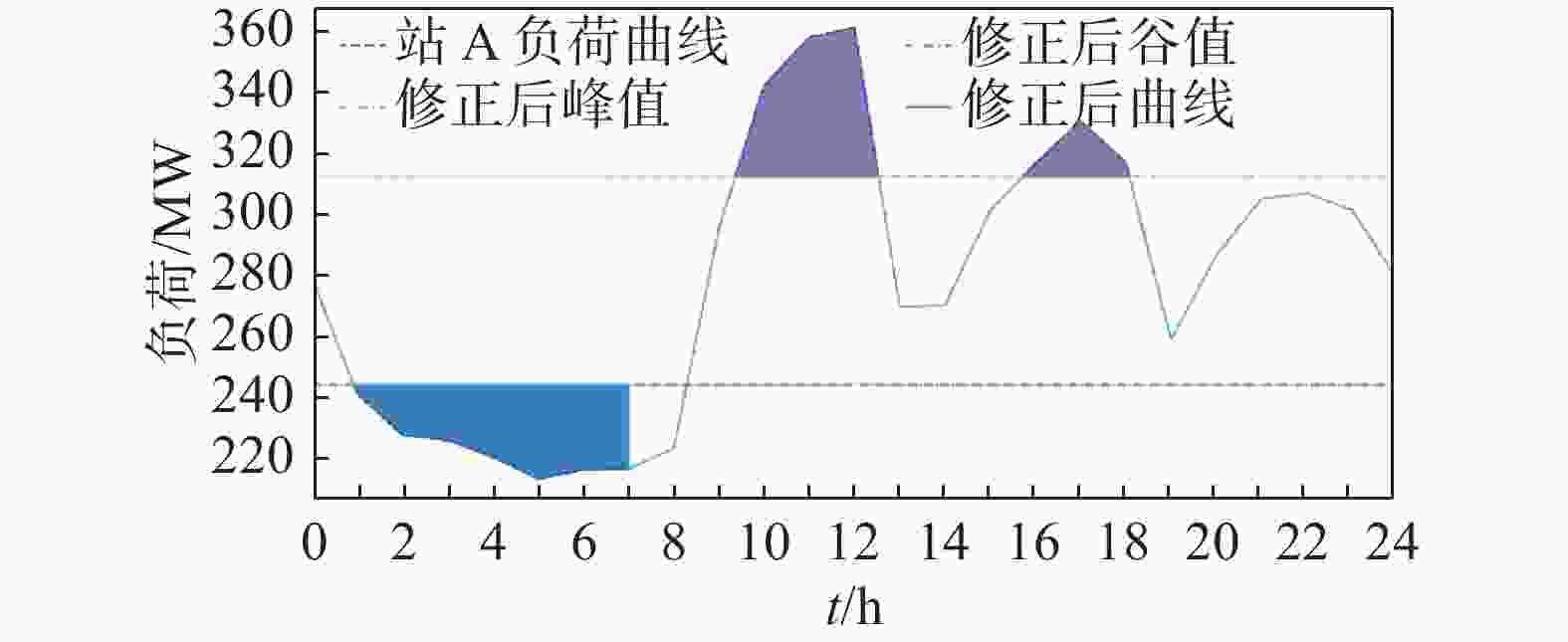
Figure 4. Example diagram of typical daily peak load shaving of energy storage under the highest load in substation A
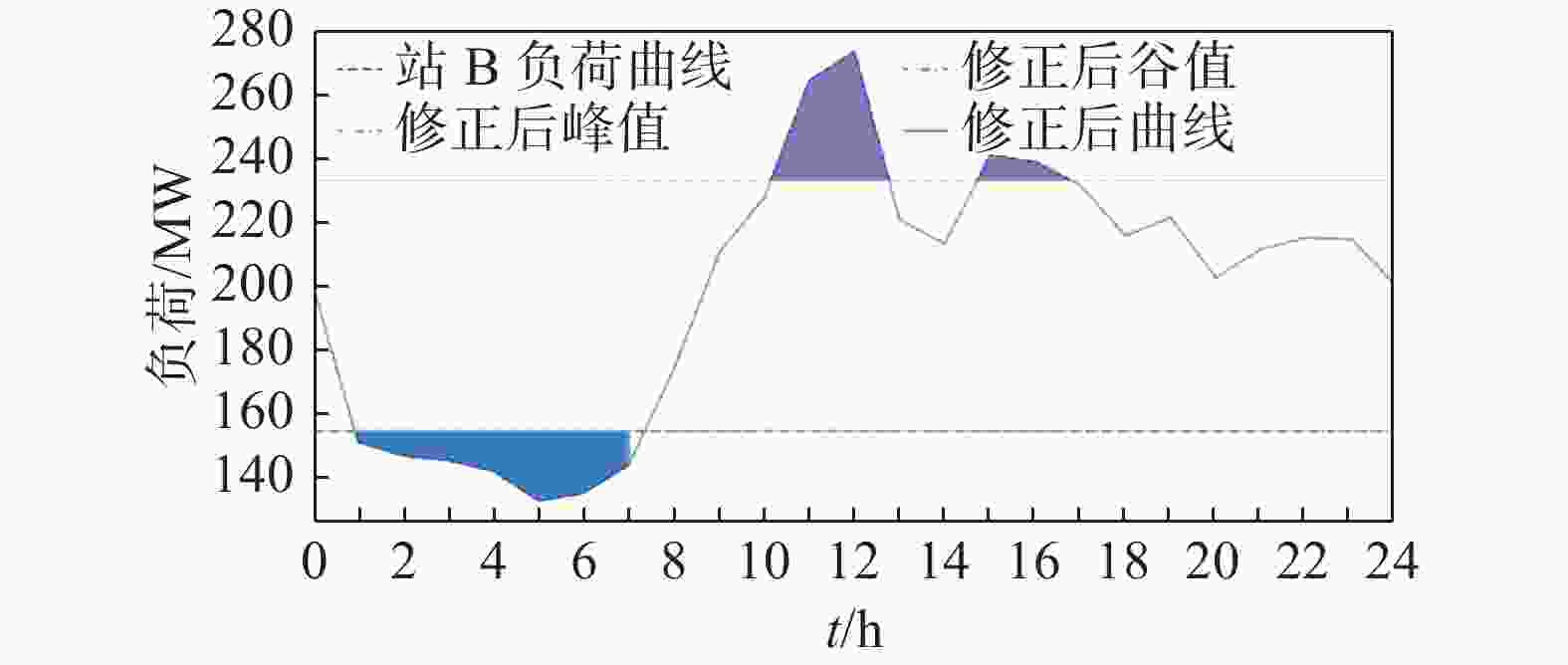
Figure 5. Example diagram of typical daily peak load shaving of energy storage under the highest load in substation B
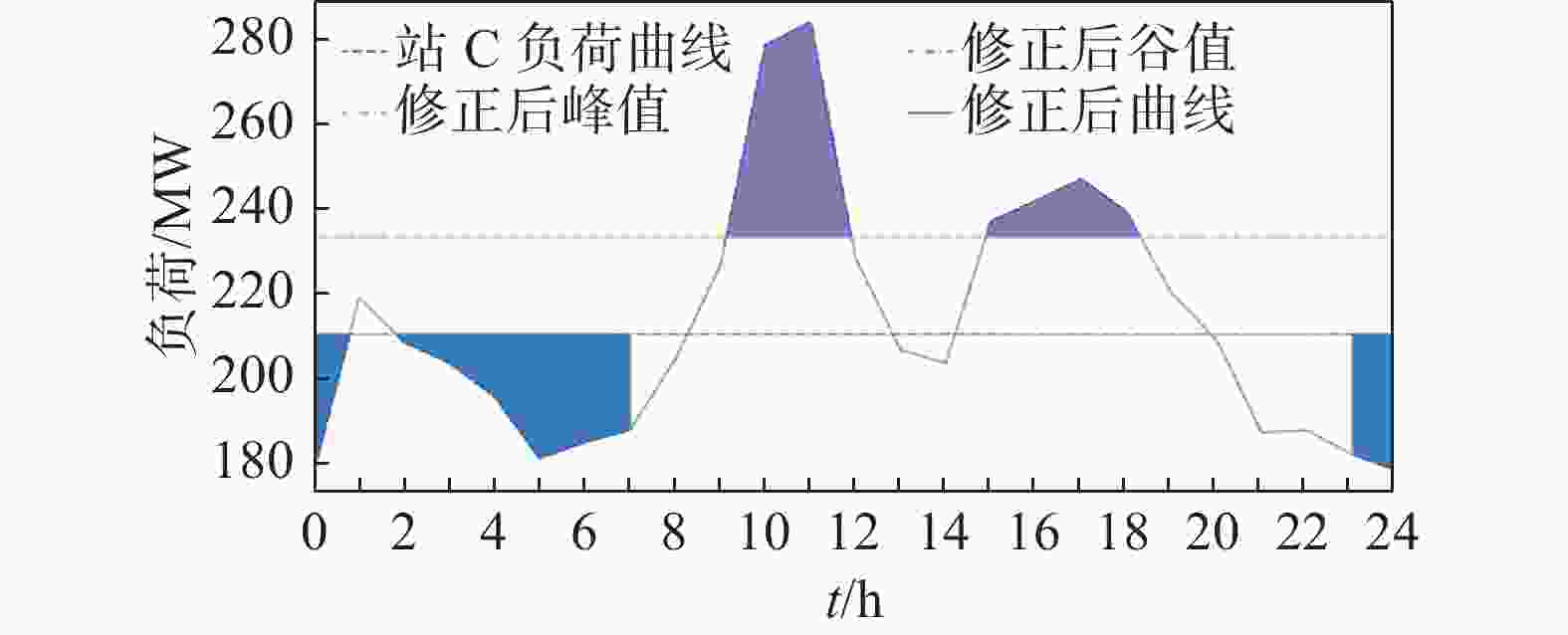
Figure 6. Example diagram of typical daily peak load shaving of energy storage under the highest load in substation C
1)变电站A、B、C负荷曲线呈现“双峰”“三峰”的多个峰值;储能所配置的削峰功率与变电站供电区负荷特性相关性较大。其中,变电站C尖峰负荷最为突出,所需储能功率最大(51 MW),占变电站变电容量14%。变电站A、B峰值相对较小,需配置约10%储能。
2)3座变电站峰值时间持续均相对较长,需要的削峰容量相对较高。结合变电站配置储能功率,3座变电站需配置的储能充放电小时数在2~3 h,略长于多数已建储能装置(2 h)。
3)通过配置一定规模的储能后,能够削峰填谷,起到平滑负荷曲线的效果;但考虑电价低谷时段与变电站负荷低谷时期不完全重合,考虑经济效益的储能填谷效应相对较差。
-
针对前述储能配置情况,结合储能定容经济可行性分析法进行经济可行性分析,可得不同储能造价水平下各站比选方案经济特性曲线如图7~图9。
在4.1节参数基础上,变电站A、B、C对应的储能系统成本最大经济容许值分别约为1 223元/kWh、1 272元/kWh、1 246元/kWh。当储能单位容量建设投资高于以上最大经济容许值时,建设储能而推迟主变扩建方案经济效益高于直接扩建主变方案。
变电站A、B、C方案一经济特性对比如图10所示。方案一(储能方案)经济特性斜率主要取决于储能系统容量,截距主要取决于储能系统容量、主变推迟投产时间等。
因此,变电站A经济特性低幅度最大,变电站C次之,变电站B最小。当储能系统成本高于约1 162元/kWh时,站A配置储能总投资高于其他两站;当储能系统成本低于1 220元/kWh时,站C配置储能总投资将低于其他两站,说明随着储能系统成本降低,储能峰谷差调峰效益将在储能配置中占主导作用。
-
结合前文算例分析,可得在考虑满足主变N-1原则下,推迟主变扩建3~5 a投产,变电站配置储能功率占本期主变容量10%~15%,最大充放电时长2~3 h,如表4。
变电站 主变容量/
MVA储能最大充放电
小时数/h储能功率占主变
百分比/%站A 2×240 2.83 10.0 站B 2×180 1.94 11.4 站C 2×180 2.45 14.2 Table 4. Overview of energy storage in substations
随着远景大规模电动汽车、新能源等具有尖峰负荷特性的资源接入,变电站供电高峰负荷可能进一步提高,负荷曲线出现更为明显的尖峰,从而提高变电站最高负载率,对配建储能的削峰功率要求有所提高。
另一方面,由于尖峰负荷占比增大,实际负荷利用小时数可能有所降低,则变电站降压负荷利用小时数相应下降,高峰负荷持续时间缩短,对配建储能的容量需求随之减小。
因此,结合前文分析配置储能规模,建议新建站储能功率按变电站容量(2台主变)的15%预留,充放电时长取2 h。
远景随着储能技术的提升和应用的成熟,储能造价也将大幅降低,配置储能的经济性更优,待储能系统单位造价降低至1 200元/kWh及以下时,可考虑结合技术分析,进一步扩大储能配置的比例。
-
针对现有电网变电站短时负载较高的问题,本文提出满足主变N-1原则的变电站储能定容方法:
1)通过分析储能削峰填谷机理,建立储能定容模型,计算得到满足既定目标下的储能额定功率及容量等建设规模。
2)根据建设储能通过推迟主变扩建、削峰填谷获取收益途径分析,建立储能电容经济目标函数。
本文结合实际变电站运行曲线、主变参数等,利用储能定容方法计算合理储能容量,并开展经济性分析。根据本文分析,得出以下结论:
1) 以满足主变N-1原则的储能配置可根据变电站主变参数、实际负荷及运行曲线等确定储能规模,解决变电站短时重载问题。随着未来尖峰负荷的发展,初步建议储能功率可按照变电站容量15%、充放电时长2 h考虑。
2) 现状储能系统单位造价相对较高,建设储能经济优势不明显,待储能系统单位造价降低至1 200元/kWh左右时,建设储能的经济优势将有所提高,可考虑优先建设变电站储能方案。
3) 结合未来分布式可再生能源的发展,变电站供电区内负荷、电源特性将有所变化,建议后续可开展以主变N-1原则为主,综合统筹区域可再生能源等多项边界的储能电容方法分析工作。
Capacity Sizing Method and Economic Analysis of Energy Storage in Substations Meeting N-1 Criterion of Main Transformers
doi: 10.16516/j.gedi.issn2095-8676.2023.02.011
- Received Date: 2022-07-15
- Rev Recd Date: 2022-09-01
- Available Online: 2023-03-13
- Publish Date: 2023-03-25
-
Key words:
- short-term heavy load /
- N-1 criterion of main transformers /
- energy storage /
- energy storage capacity sizing /
- economic objective function
Abstract:
| Citation: | DING Xiuxiang, LIN Wei, CHEN Kuncan, XIE Huiling. Capacity Sizing Method and Economic Analysis of Energy Storage in Substations Meeting N-1 Criterion of Main Transformers[J]. SOUTHERN ENERGY CONSTRUCTION, 2023, 10(2): 78-85. doi: 10.16516/j.gedi.issn2095-8676.2023.02.011 |


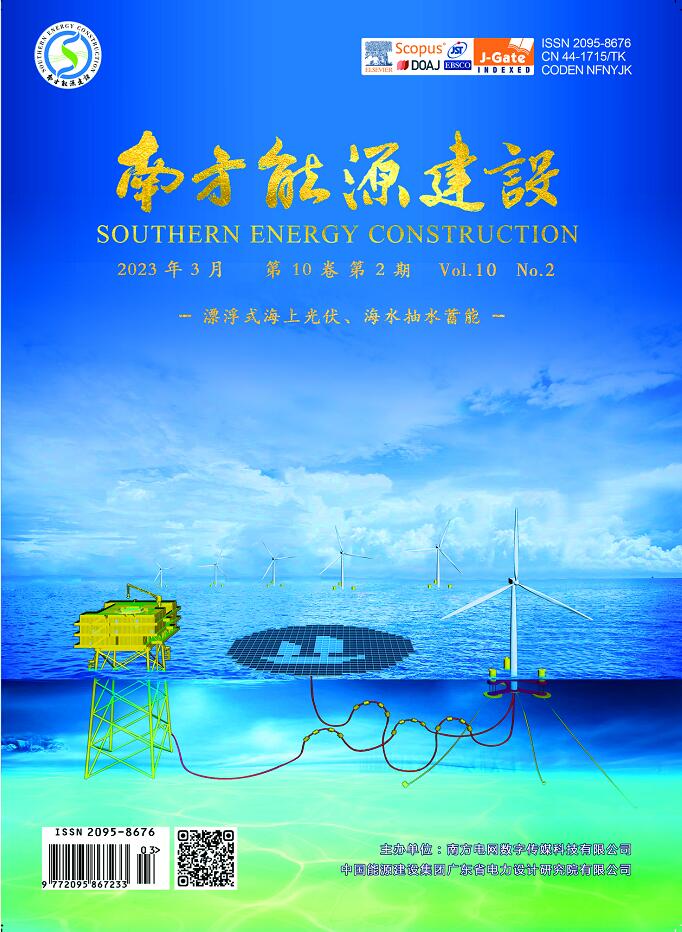

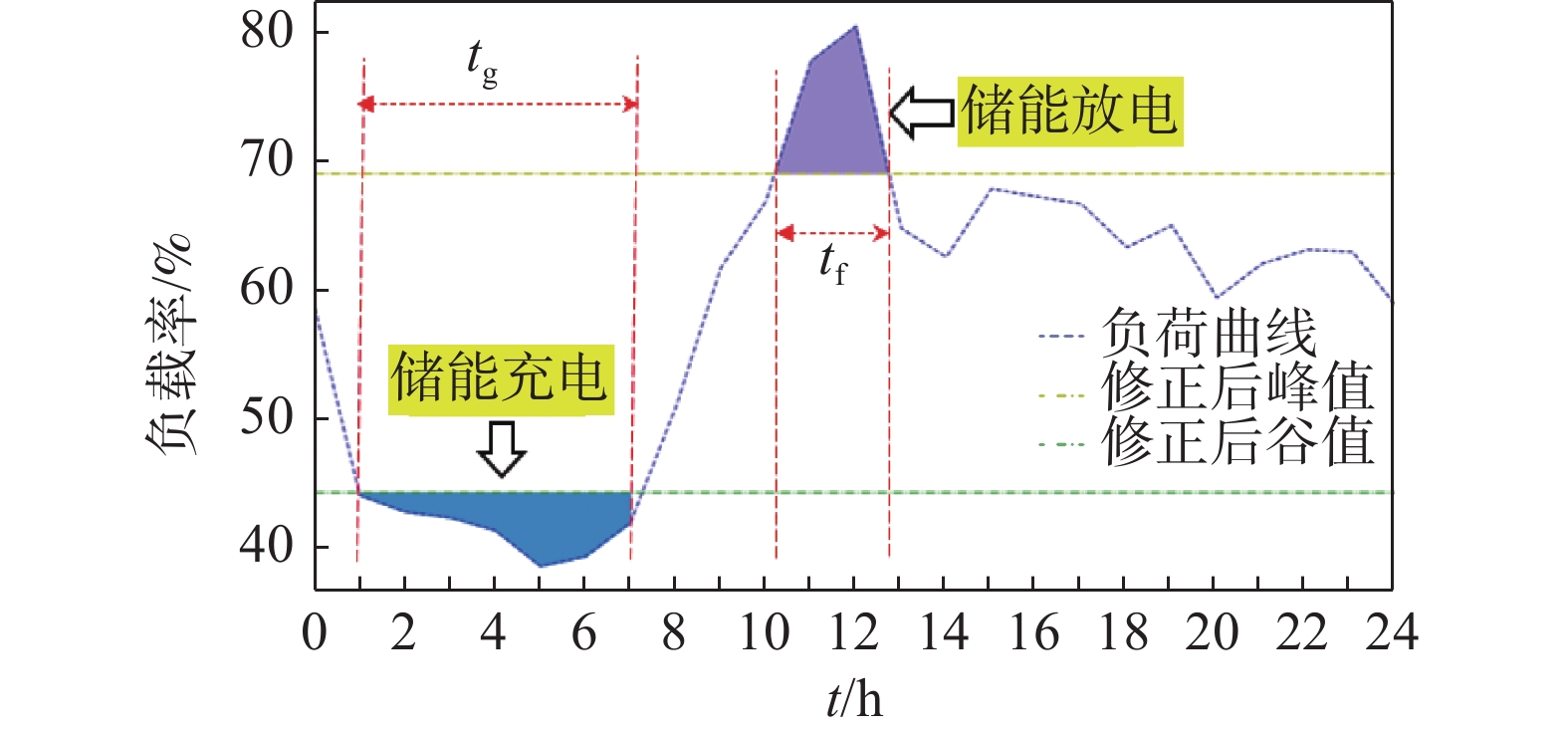







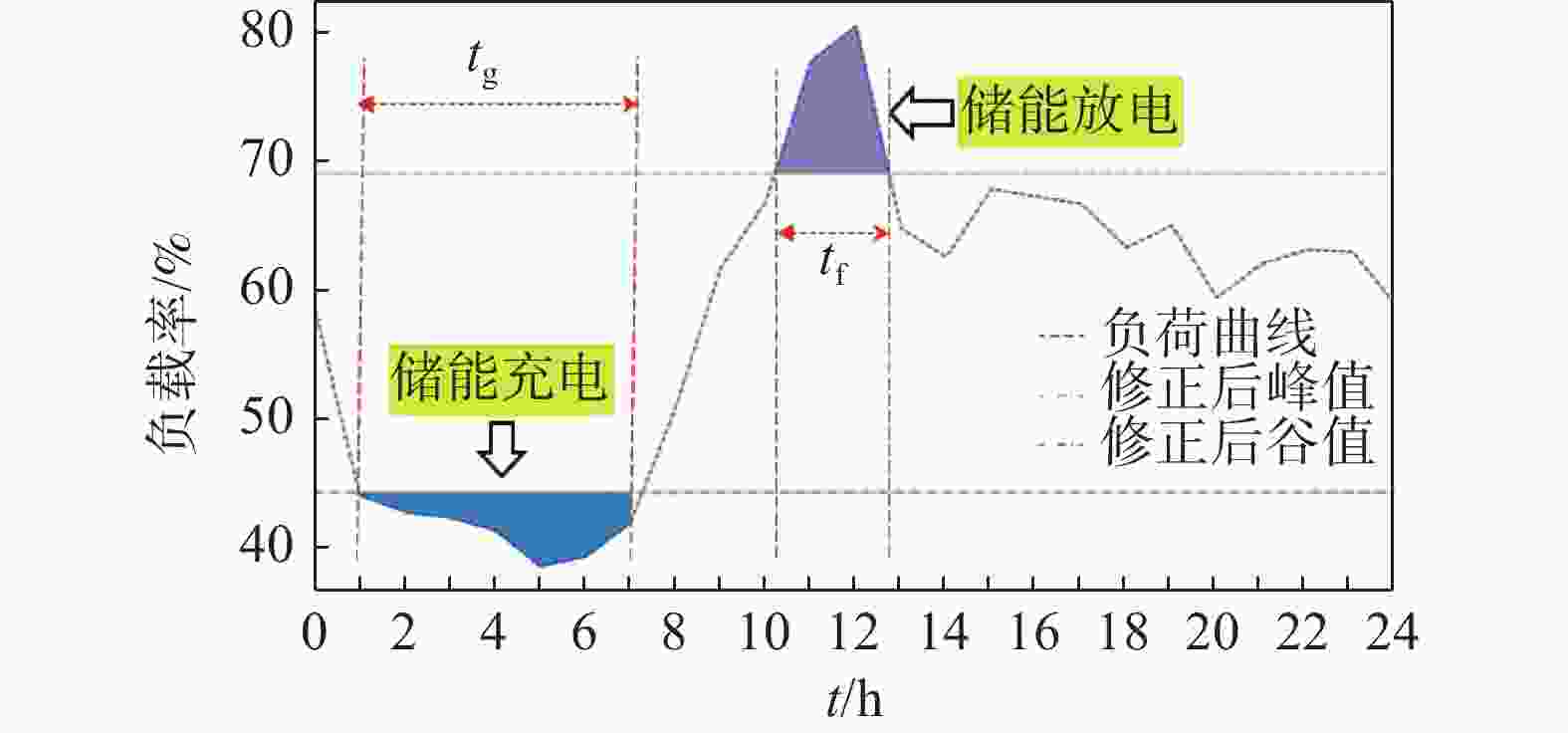













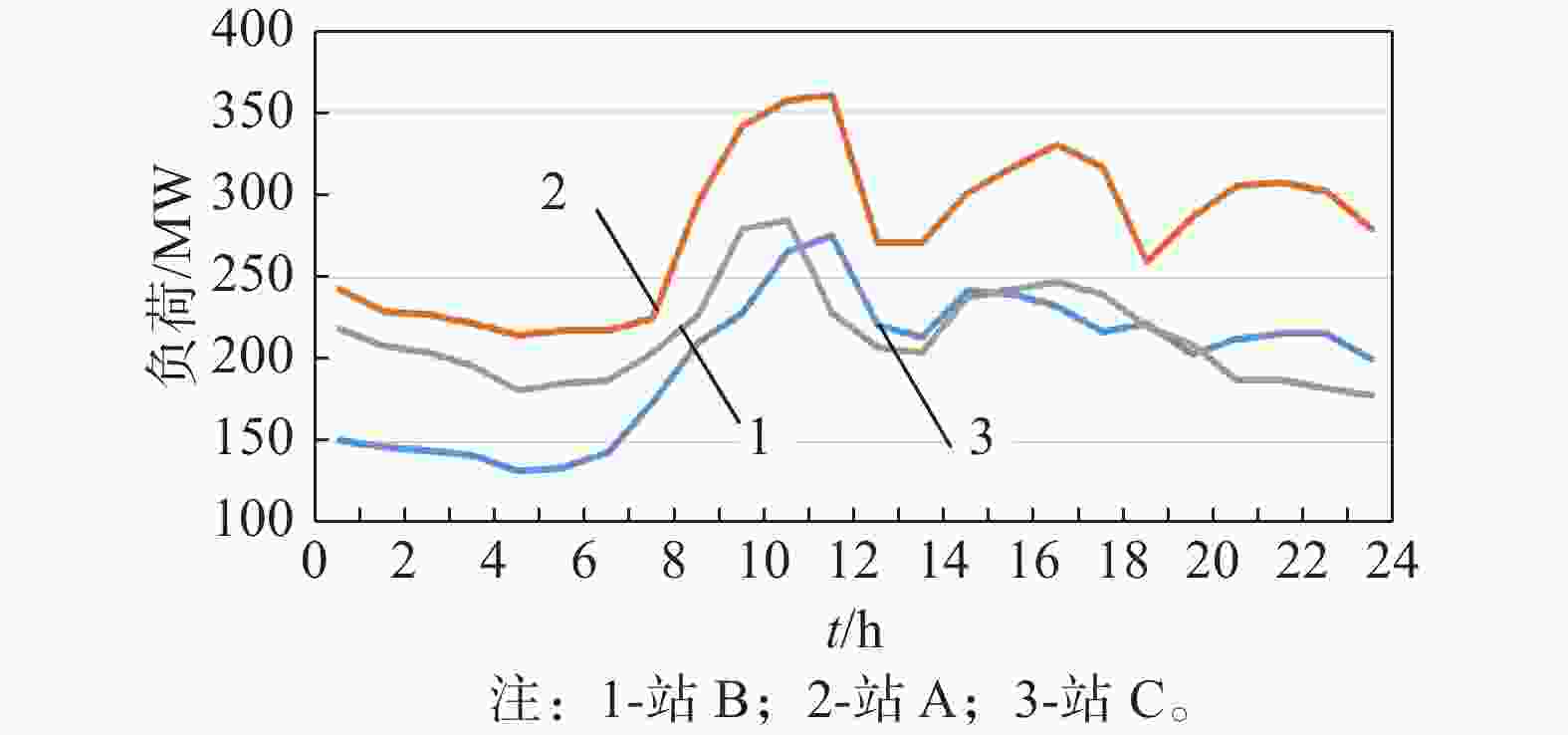
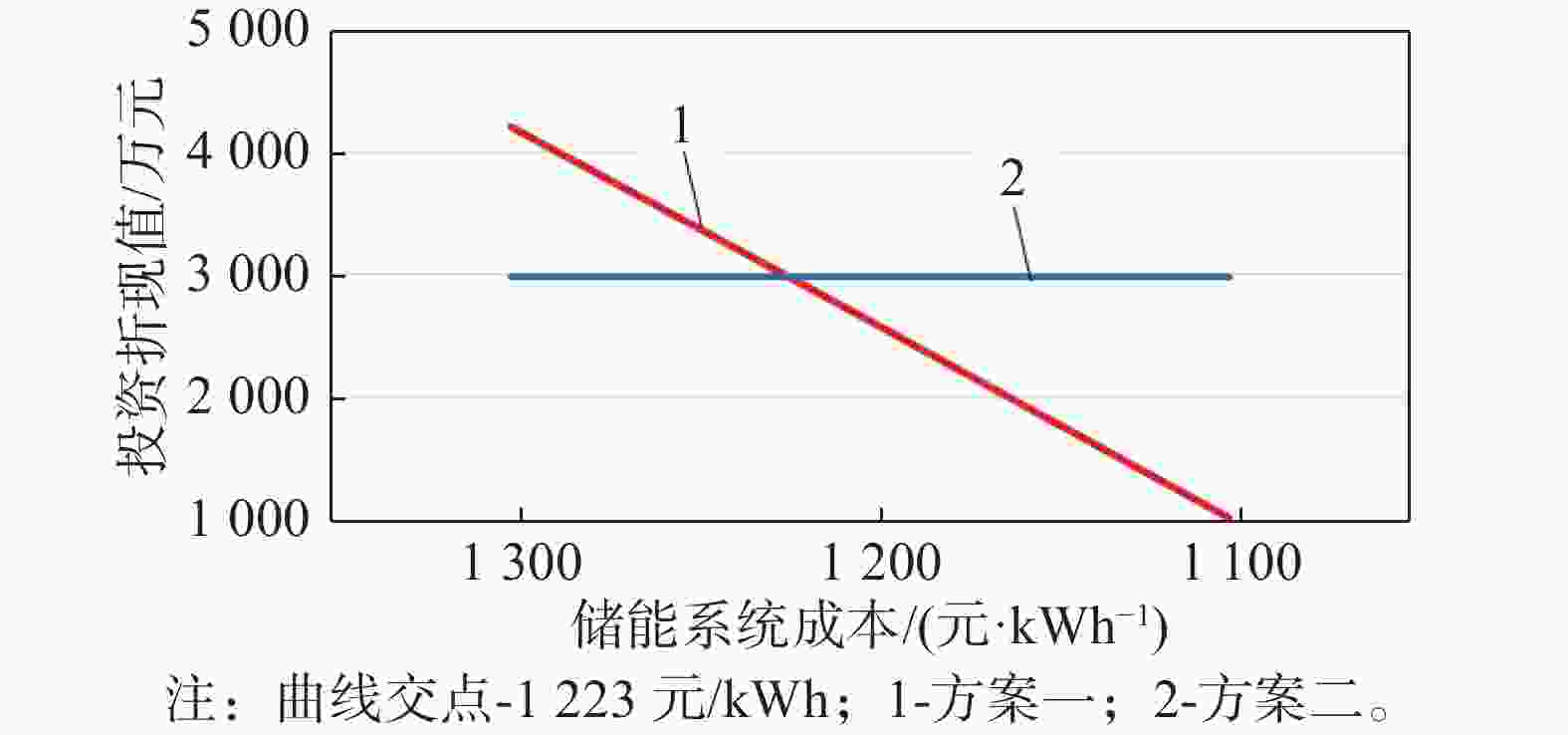
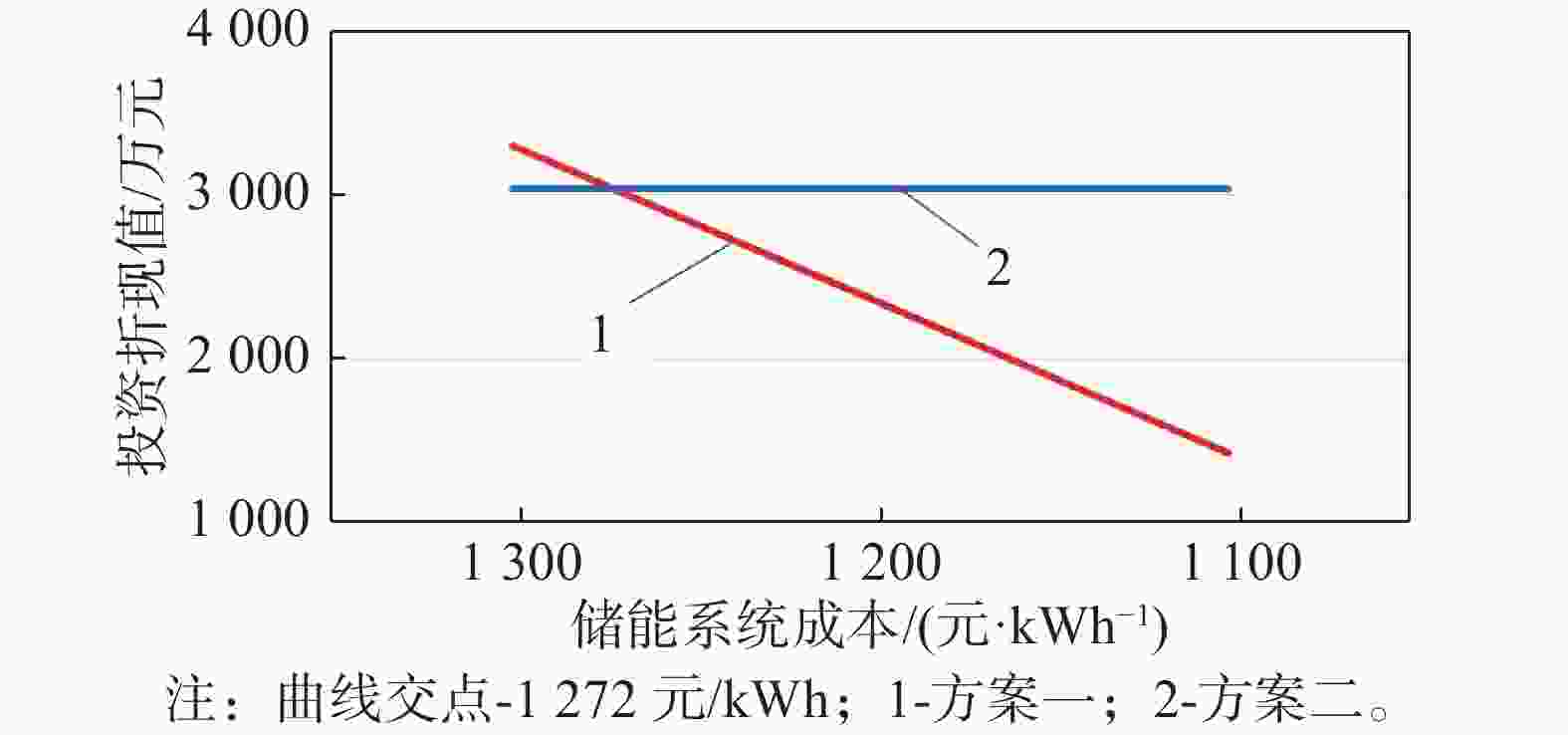
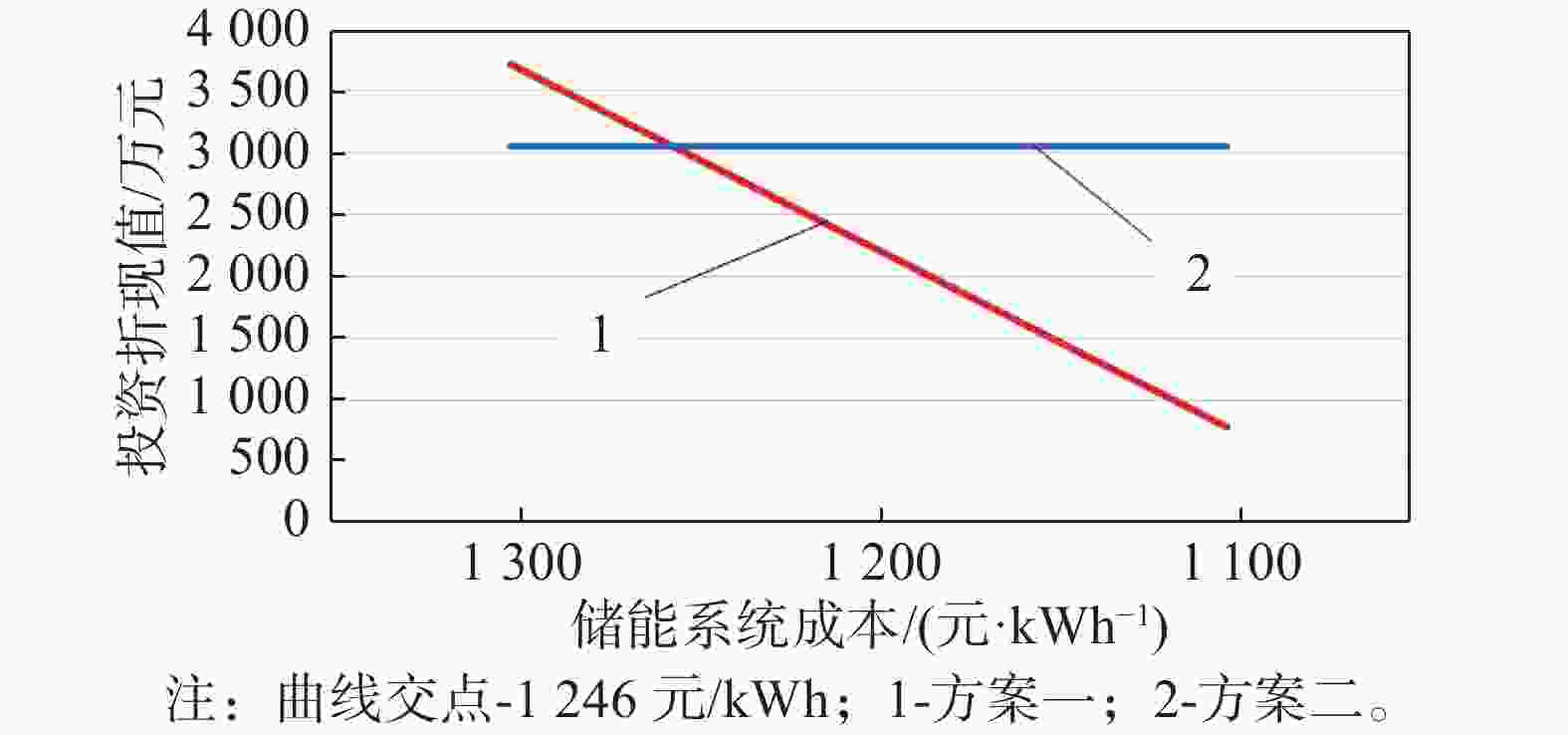
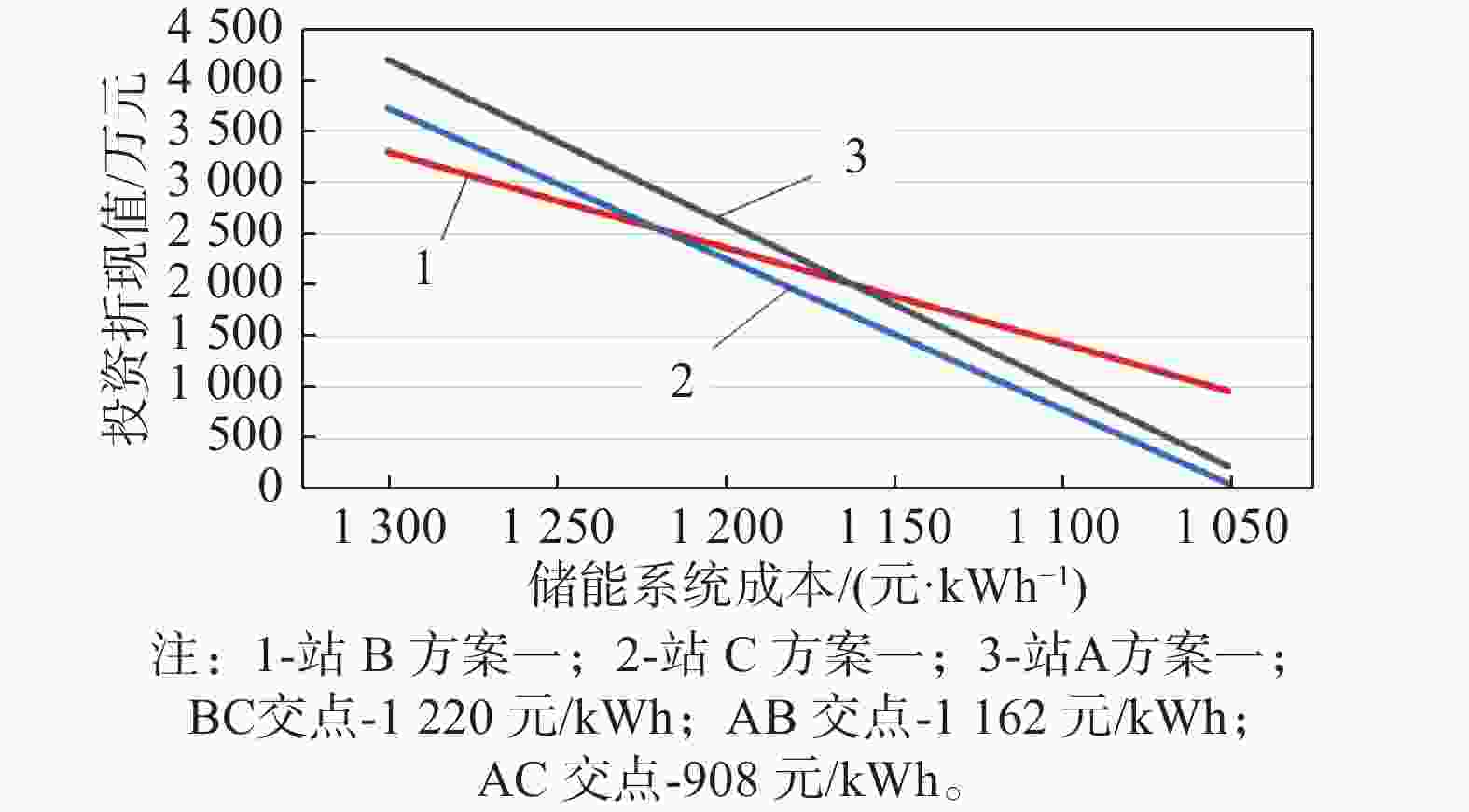

 DownLoad:
DownLoad:
